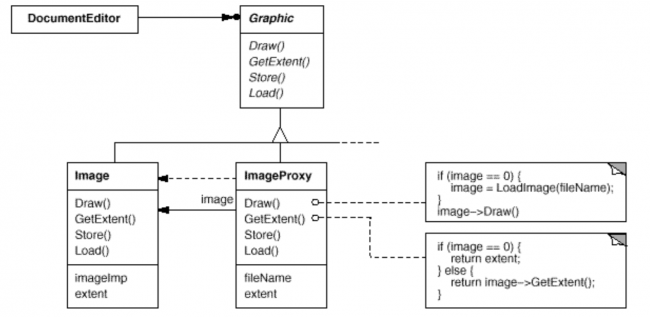Proxy
This article is fully based on Gamma's Design Patterns, Elements of Reusable Object-Oriented Software [1].
Intend
Provide a surrogate or placeholder for another object to control access to it. Also know as Surrogate.
Motivation

One reason for controlling access to an object is to defer the full cost of its creation and initialization until we actually need to use it. Consider a document editor that can embed graphical objects in a document. Some graphical objects, like large raster images, can be expensive to create. But opening a document should be fast, so we should avoid creating all the expensive objects at once when the document is opened. This isn't necessary anyway, because not all of these objects will be visible in the document at the same time.
These constraints would suggest creating each expensive object on demand, which in this case occurs when an image becomes visible. But what do we put in the document in place of the image? And how can we hide the fact that the image is created on demand so that we don't complicate the editor's implementation? This optimization shouldn't impact the rendering and formatting code, for example.
The solution is to use another object, an image proxy, that acts as a stand-in for the real image. The proxy acts just like the image and takes care of instantiating it when it's required.
The image proxy creates the real image only when the document editor asks it to display itself by invoking its Draw operation. The proxy forwards subsequent requests directly to the image. It must therefore keep a reference to the image after creating it.
Let's assume that images are stored in separate files. In this case we can use the file name as the reference to the real object. The proxy also stores its extent, that is, its width and height. The extent lets the proxy respond to requests for its size from the formatter without actually instantiating the image.
The following class diagram (Proxy Class Diagram) illustrates this example in more detail.

The document editor accesses embedded images through the interface defined by the abstract Graphic class. ImageProxy is a class for images that are created on demand. ImageProxy maintains the file name as a reference to the image on disk. The file name is passed as an argument to the ImageProxy constructor.
ImageProxy also stores the bounding box of the image and a reference to the real Image instance. This reference won't be valid until the proxy instantiates the real image. The Draw operation makes sure the image is instantiated before forwarding it the request. GetExtent forwards the request to the image only if it's instantiated; otherwise ImageProxy returns the extent it stores.
Applicability
Proxy is applicable whenever there is a need for a more versatile or sophisticated reference to an object than a simple pointer. Here are several common situations in which the Proxy pattern is applicable:
- A remote proxy provides a local representative for an object in a different address space. NEXTSTEP uses the class NXProxy for this purpose. Coplien calls this kind of proxy an "Ambassador."
- A virtual proxy creates expensive objects on demand. The ImageProxy described in the Motivation is an example of such a proxy.
- A protection proxy controls access to the original object. Protection proxies are useful when objects should have different access rights. For example, KernelProxies in the Choices operating system provide protected access to operating system objects.
- A smart reference is a replacement for a bare pointer that performs additional actions when an object is accessed. Typical uses include
- counting the number of references to the real object so that it can be freed automatically when there are no more references
- loading a persistent object into memory when it's first referenced.
- checking that the real object is locked before it's accessed to ensure that no other object can change it.
See also
Reference
- ↑ Design Pattern, Elements of Reusable Object-Oriented Software, Erich Gamma, Ralph Johnson, Richard Helm, John Vlissides, First Published: October 21, 1994